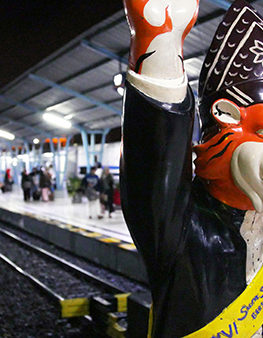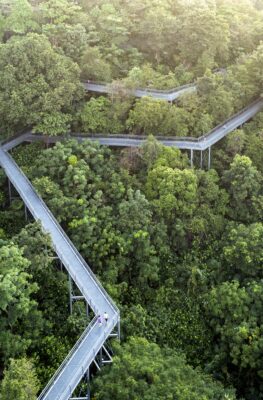Published on December 25, 2015
Juvenile orangutan at Sepilok, Malaysia. Image © Tourism Malaysia, used with permission.
Within its mangrove forests, tropical jungles and plains, Southeast Asia cradles an almost unimaginable diversity of wildlife. Animals endemic to the region encompass the large and the small, winged and web-footed, sharp-toothed predators and docile, herbivorous prey alike.
This embarrassment of natural riches provides a travel experience on par with the region’s iconic temples and stunning beaches. With so many options, where do you begin? Here’s a small sampling of places that offer encounters with the region’s most treasured animals.
Brunei’s mangrove forests. Brunei Bay is home to the proboscis monkey. Sporting reddish fur, a large belly, a long white tail, and a pendulous, distinctive nose, this unique species of primates has made its own kingdom out of a thick mangrove forest lining the river that runs down to the Bay.
Adjacent to the capital, Brunei Darussalam, the Bay is easily accessible by boat. Mangrove safari tours run in the morning and in the late afternoon, when the monkeys are at their most active.
Sepilok Orangutan Rehabilitation Center. A stalwart in the conservation of Malaysia’s orangutan population, Sepilok Rehabilitation Center in Sabah, East Malaysia is a must-see for animal-lovers. The center rescues baby orangutans from logging sites, illegal hunting, and the pet trade.
The captive orangutans are cared for at the center and eventually reintroduced into the wild. Visitors can watch orangutans during feeding time and delight in the antics of baby orangutans in the nursery area, where they learn to climb and play.
Night Safari in Singapore. Image © Tourism Singapore, used with permission.
Wildlife Reserves Singapore Parks. Singapore may be lacking in endemic flora and fauna compared to its neighbors, but this small country has made massive strides in wildlife conservation. To date, it is a must-see destination for wildlife enthusiasts, thanks to Wildlife Reserves Singapore, a self-funded organization that runs Singapore’s foremost zoos and wildlife parks.
Each of Wildlife Reserves Singapore’s parks is number one in its chosen area of coverage.
Opened in 1971, Jurong Bird Park, for starters, is the largest of its kind in Asia at over 202,000 square meters in size, with 5,000 birds from 380 species. Jurong Bird Park is also home to four large free-flight aviaries which mirror the natural habitats of birds from all over the world. The iconic Waterfall Aviary is the park’s largest walk-in aviary that houses over 600 birds as well as a 30-metre high waterfall.
The Night Safari is home to over 2,500 animals from 130 species, of which 38% are threatened. It also holds the distinction of being the world’s first nocturnal zoo. The award-winning Singapore Zoo’s 26 hectares currently hosts over 2,800 animals and 300 species in open spaces which mimic their natural habitats, as well as contribute significantly to the global conservation effort with its captive breeding programmes of endangered animals.
Finally, the River Safari is the latest addition to the impressive list of WRS parks. It profiles freshwater habitats from iconic rivers of the world such as the Amazon River, Mekong River and River Nile which shelters 300-plus species of over 5,000 animals, including a pair of rare Giant Pandas.
For more information, please visit: http://www.wrs.com.sg
Philippine Eagle Center. The Philippine Eagle is one of the largest eagles in the world and, sadly, also one of the closest to extinction. The Philippine Eagle Center in Davao City serves as a haven for these majestic birds of prey; currently, the non-profit center houses 36 eagles and a number of other species of birds, mammals, and reptiles.
Visitors can sign up for a tour of the facility, located at the foot of the Philippines’ Mount Apo. The eagles live in spacious cages that simulate their natural habitat. The center’s landscaped pathways and gardens also provide for a pleasant stroll or a picnic for its visitors.
Khao Yai National Park. Image © Tourism Authority of Thailand, used with permission.
Wildlife Sanctuary in Thailand. Khao Yai National Park and Thung Yai Naresuan Wildlife Sanctuary are well-known for their complex mountainous area with an abundance of wildlife including rare and preserved animals; such as, sun bear, deer, bison, and wild elephant.
The elephant is the national symbol of Thailand. Not only in the forest, but elephants can also be found in many areas throughout Thailand, especially in the Northern Thailand. The Thai Elephant Conservation Centre in Lampang and the Elephant Nature Park in Chiang Mai are recommended. The Elephant Nature Park treat elephants like the noble animals that they are. Elephants rescued from abusive captivity are brought and placed, finally, back where they belong: surrounded by fellow elephants in a protected safari where they’re free to roam and reintegrate into the herd. For the true elephant-lover, these sanctuaries are a bright ray of hope for elephant conservation and welfare.






